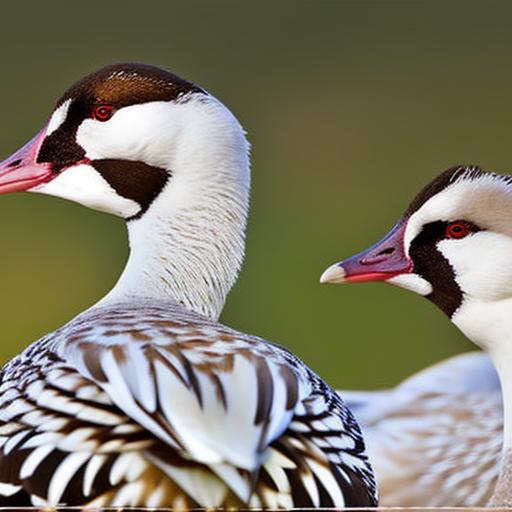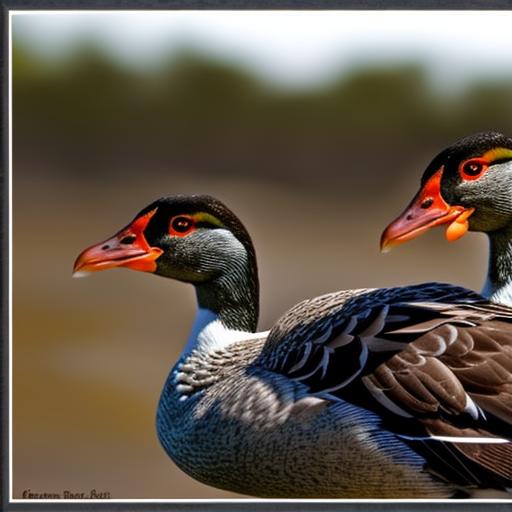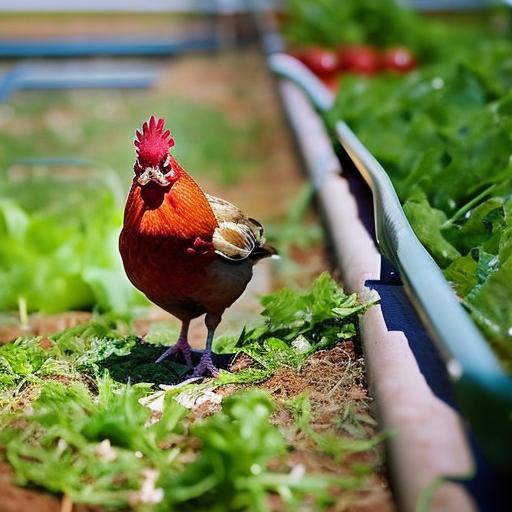Geese have been domesticated for thousands of years, with evidence of their presence in ancient Egyptian, Greek, and Roman cultures. The ancient Egyptians revered geese for their role in pest control, as they were known to eat insects and weeds in agricultural fields. In ancient Greece, geese were also valued for their ability to act as watchdogs, alerting farmers to the presence of intruders. The Romans, on the other hand, prized geese for their meat and feathers, and they were often featured in feasts and celebrations.
As time passed, geese became an integral part of agricultural societies across the world. In Europe, geese were raised for their meat, eggs, and feathers, and they were often kept in small flocks on family farms. In Asia, geese were also valued for their pest control abilities, and they were often used to keep rice paddies free of insects and weeds. In more recent times, domestic geese have become popular as pets and for exhibition purposes, with breeders working to develop new and unique varieties of geese for show and competition.
The Different Types of Domestic Geese: A Guide to Popular Breeds
There are many different breeds of domestic geese, each with its own unique characteristics and traits. Some of the most popular breeds include the Toulouse, Embden, Chinese, and African. The Toulouse is a large, heavy breed known for its calm and gentle nature, making it a popular choice for meat production. The Embden, on the other hand, is a white breed with a distinctive orange bill and legs, and it is prized for its meat and eggs. The Chinese breed is known for its striking appearance, with a knob on its head and a distinctive waddle under its chin. The African breed is a smaller, more agile breed, often used for weeding and pest control in agricultural settings.
Each breed of domestic geese has its own unique characteristics and traits, making them suitable for different purposes. Some breeds are better suited for meat production, while others are prized for their eggs or their ability to act as watchdogs or pest controllers. When choosing a breed of domestic geese, it is important to consider the specific needs and requirements of the intended purpose, as well as the climate and environment in which the geese will be raised.
Understanding the Characteristics and Behaviors of Domestic Geese
Domestic geese are known for their social nature and strong bond with their flock mates. They are highly intelligent animals, with a keen sense of awareness and a strong instinct for self-preservation. Geese are also known for their strong maternal instincts, with female geese fiercely protective of their eggs and goslings. They are also known for their loud and distinctive honking, which they use to communicate with each other and to alert the flock to potential dangers.
Geese are also known for their strong migratory instincts, with many breeds of domestic geese retaining the ability to fly long distances. This can pose a challenge for breeders and farmers, as geese are known to wander and explore their surroundings, often straying far from their home base. However, with proper training and management, geese can be taught to stay within a designated area, making them easier to care for and manage.
The Role of Domestic Geese in Agriculture and Conservation Efforts
Domestic geese have long been valued for their contributions to agriculture and conservation efforts. In agricultural settings, geese are often used for weeding and pest control, as they are known to eat insects and weeds that can damage crops. They are also valued for their meat and eggs, providing a source of food and income for farmers and breeders. In conservation efforts, geese are often used to restore and maintain natural habitats, as they can help control invasive plant species and restore balance to ecosystems.
In recent years, domestic geese have also been used in conservation efforts to help restore and protect endangered species. By using geese to control invasive plant species and restore natural habitats, conservationists are able to create a more hospitable environment for endangered species to thrive. This has proven to be an effective and sustainable method of conservation, as geese are able to provide natural and non-invasive solutions to environmental challenges.
Breeding and Raising Domestic Geese: Tips for Success
Breeding and raising domestic geese can be a rewarding and fulfilling experience, but it also requires careful planning and management. When breeding geese, it is important to select healthy and genetically diverse breeding stock, as this will help ensure the health and vitality of the offspring. It is also important to provide a suitable environment for breeding, with plenty of space and access to fresh water and nutritious feed.
When raising domestic geese, it is important to provide a safe and secure environment, with protection from predators and access to clean water and nutritious feed. Geese are social animals and thrive in the company of their flock mates, so it is important to provide ample space for them to roam and interact with each other. It is also important to provide regular health checks and vaccinations to prevent the spread of disease and ensure the overall well-being of the flock.
The Unique Qualities of White Feathered Domestic Geese Breeds
White feathered domestic geese breeds are known for their striking appearance and elegant presence. The pure white feathers of these breeds are often prized for their beauty and grace, making them a popular choice for exhibition and show purposes. Some of the most popular white feathered domestic geese breeds include the Embden, Toulouse, and Chinese breeds, each with its own unique characteristics and traits.
The Embden breed is known for its large size and distinctive orange bill and legs, making it a striking and impressive bird. The Toulouse breed is also large and heavy, with a calm and gentle nature that makes it a popular choice for meat production. The Chinese breed is known for its unique appearance, with a knob on its head and a distinctive waddle under its chin, making it a popular choice for exhibition and show purposes. These breeds are prized for their beauty and elegance, making them a popular choice for breeders and enthusiasts alike.
White Feathered Beauties: Showcasing the Elegance and Grace of Domestic Geese
White feathered domestic geese breeds are often showcased in exhibitions and shows, where their beauty and grace can be admired by enthusiasts and breeders. These birds are often judged on their appearance, with points awarded for their size, shape, and overall presence. Breeders work tirelessly to develop and improve the characteristics of these breeds, with the goal of producing birds that are true to the breed standard and exhibit the desired traits and qualities.
In addition to their beauty, white feathered domestic geese breeds are also valued for their meat and eggs, making them a versatile and valuable addition to any farm or homestead. Their calm and gentle nature also makes them a popular choice for pets and companions, with many people enjoying the company of these elegant and graceful birds. Whether raised for exhibition, meat, or companionship, white feathered domestic geese breeds are a valuable and cherished part of the agricultural and domestic landscape.
The Importance of Preserving and Protecting Domestic Geese Breeds
Preserving and protecting domestic geese breeds is essential for maintaining genetic diversity and ensuring the long-term viability of these valuable animals. Many breeds of domestic geese are at risk of extinction, as they are often overshadowed by more popular and commercially viable breeds. By preserving and protecting these breeds, we can help ensure that they continue to thrive and contribute to agriculture, conservation, and cultural heritage.
Conservation efforts are underway to protect and preserve domestic geese breeds, with organizations and breeders working to raise awareness and promote the value of these animals. By supporting and promoting the use of domestic geese in agriculture and conservation efforts, we can help ensure that these breeds continue to play a vital role in our society. By preserving and protecting domestic geese breeds, we can help ensure a sustainable and diverse future for agriculture and conservation.
Domestic Geese in Art, Literature, and Folklore: A Cultural Perspective
Domestic geese have long been a source of inspiration and fascination in art, literature, and folklore. In many cultures, geese are revered for their beauty, grace, and intelligence, and they are often featured in stories, songs, and artwork. In ancient Greek mythology, geese were associated with the goddess Aphrodite, and they were often depicted as symbols of love and fidelity. In Chinese culture, geese are often associated with longevity and prosperity, and they are often featured in traditional artwork and literature.
In literature, geese are often used as symbols of loyalty, courage, and wisdom, with many stories and fables featuring geese as central characters. In art, geese are often depicted in paintings, sculptures, and other forms of visual art, with their elegant and graceful presence captured in various mediums. In folklore, geese are often featured in traditional stories and legends, with their unique characteristics and behaviors celebrated and revered.
The Future of Domestic Geese Breeds: Trends and Developments in the Industry
The future of domestic geese breeds is bright, with a growing interest in sustainable and heritage breeds. As more people become aware of the value and versatility of domestic geese, there is a renewed interest in preserving and promoting these breeds. Breeders and enthusiasts are working to develop and improve the characteristics of domestic geese breeds, with the goal of producing birds that are true to the breed standard and exhibit the desired traits and qualities.
In addition to their value in agriculture and conservation efforts, domestic geese breeds are also gaining popularity as pets and companions. Many people are drawn to the calm and gentle nature of geese, as well as their beauty and grace. As more people seek out sustainable and heritage breeds, the demand for domestic geese is expected to grow, leading to a resurgence in the popularity and value of these valuable animals. With continued support and promotion, the future of domestic geese breeds looks promising, with a renewed focus on preserving and protecting these valuable and cherished animals.
Meet Walter, the feathered-friend fanatic of Florida! Nestled in the sunshine state, Walter struts through life with his feathered companions, clucking his way to happiness. With a coop that’s fancier than a five-star hotel, he’s the Don Juan of the chicken world. When he’s not teaching his hens to do the cha-cha, you’ll find him in a heated debate with his prized rooster, Sir Clucks-a-Lot. Walter’s poultry passion is no yolk; he’s the sunny-side-up guy you never knew you needed in your flock of friends!







